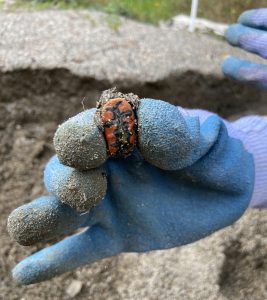

Nesting Beach at Minnekhada
If you have been to Minnekhada, you have probably noticed turtles basking on logs in the marsh on a nice, warm day. Many of the turtles you see are our native Western Painted Turtle (WPT). They are the only native freshwater turtle still seen in BC. The Western Pond Turtle, the other native turtle, has not been seen since the 1960s. Over the last few years, you may have noticed an increase in the number of turtles you see basking. Well, we have the Coastal Painted Turtle Project to thank for the increased turtle population at Minnekhada. They have successfully hatched, reared, and released many turtles into Minnekhada over the years. They built a secured nesting beach to protect the nests from predators. You can spot the nesting beach from the bridge on the Lodge Trail. If you look across the way towards the dam, you can see a sandy beach surrounded by an electric fence (in place to keep out predators). You can read more about the Coastal Painted Turtle Project here.
Coastal Painted Turtle Project are still actively monitoring and protecting turtle nest at Minnekhada and they can use your help. If you are at Minnekhada during nesting season (May-June) and you see a WPT ON LAND, please send a photo and the location of the turtle to Coastal Painted Turtle Project via Facebook Messenger – Coastal Painted Turtle Project. All other WPT sightings can be reported to their email at info@coastalpartners.ca

Other ways that you can help:
- Protect basking and nesting sites
- Slow down for turtles crossing the road
- Keep dogs on leash and on the trails
- Do not release pet turtles into the wild (see below)
- Do not disturb the turtles
- Maintain their habitat
Western Painted Turtle VS. Red Eared Sliders
As I mentioned before many of the turtles you see basking on the logs are native Western Painted Turtles, but what else is out there? Another common turtle seen at Minnekhada is the Red-Eared Slider (RES). This turtle is not native to BC and is considered invasive. They are often released house pets and can cause a lot of damage to an ecosystem. They are much larger than our native WPT, so they often outcompete them for the limited resources at a site. Diseases and parasites introduced by the release of RES can also be a problem for WPT. That is why it is extremely important to not release your pet turtle into any natural habitat as they can become a big problem over time.

Red-Eared Slider

Western Painted Turtle
The easiest way to tell the difference between a RES and our native WPT is to look at their ears. As the name suggests, the RES will have a red mark behind their year, while the WPT will not. Another easy way to tell the difference is if you can see their underside (plastron). The WPT underside is bright red or orange, while the RES underside is pale-yellow color. You can also tell by the shape of their shell. The WPT will have a smoother and flat-shaped shell, while the RES will have a rougher and dome-shaped shell.
Western Painted Turtles Life-Cycle
They prefer to live in the shallow waters of ponds, lakes, marshes, and slow-moving streams. Ideally, their habitat has a muddy bottom, a lot of vegetation, and basking locations. As with many turtle species, they are long-lived and can live more than 50 years in the wild. Males become sexually mature around 4/5 years of age while females not until they are about 7/8 years old. Mating begins almost as soon as turtles become active in the spring and last throughout the summer and early fall. A female turtle may mate with more than one male during a breeding season and have a clutch with multiple paternities. A female can even store viable sperm for more than a year.

Minnekhada Nesting Beach September 2021

Minnekhada Nesting Beach September 2021
In BC, female WPTs nest from late May through June. To build a nest, a female will dig a flask-shaped hole within 200 m of the water. The nest will be anywhere from 20-30 cm deep. Females can lay more than 1 clutch in a season, although it is not the norm. Once the females lay the eggs, they are hands-off. They do not return to care for the nest or the hatchlings. The eggs will incubate throughout the summer (average 76 days) and hatch in the fall. The sex of the turtles is determined by the temperatures experienced during incubation. Warmer temperatures yields more females, while cooler temperatures yields more males. Once hatched, turtles will stay within the shallow nest until the following spring (spending the cold winter months in a shallow nest). The survival of the hatchlings depends heavily on the temperatures experienced throughout the winter. This first year is often the most dangerous for a WPT, and many eggs and hatchlings do not make it.
Adult WPT will become dormant on the muddy substrate at the bottom of the lake during the cold winter months. During the summer months, you will find adult WPT basking in the morning and throughout the day. In the cooler afternoon/evening hours, they are foraging for food in the water. They spend their nights sleeping at the bottom of the lake/pond/marsh.




